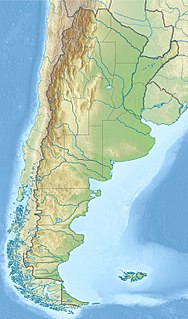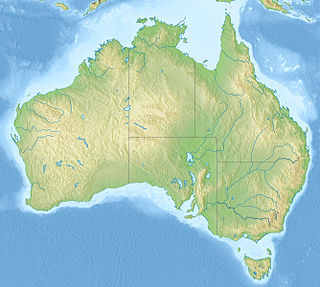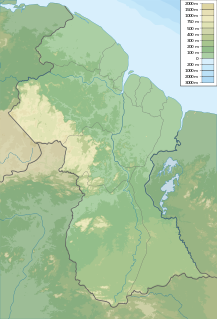The Milk River Formation is a near- shore to terrestrial sedimentary unit deposited during the Late Cretaceous in southern Alberta. It is equivalent to the marine Lea Park Formation of eastern Alberta, and the Eagle and Telegraph Creek Formations of north-central Montana, and to the upper part of the Niobrara Formation in Kansas.

The Argana Group is a geological group in the western High Atlas northeast of Agadir, Morocco. It dates back to the Late Triassic. The group contains the Timezgadiouine Formation.
The Oncala Group is a geological formation in Spain. It dates back to the Late Jurassic.
The Shishugou Formation is a geological formation in Xinjiang, China.

The Cerro Barcino Formation is a geological formation in South America whose strata span the Early Cretaceous. The top age for the formation has been estimated to be Albian. Earlier estimates placed the formation until the Campanian.

The Marree Subgroup, previously described as Maree Formation and Marree Formation, is a geological subgroup in the Eromanga Basin of South Australia whose strata date back to the Aptian. The subgroup was first described as a formation by Forbes in 1966. Dinosaur remains are among the fossils that have been recovered from the formation.

The Eumeralla Formation is a geological formation in Victoria, Australia whose strata date back to the Early Cretaceous. Dinosaur remains are among the fossils that have been recovered from the formation. It is equivalent to the Wonthaggi Formation.
The Densuş-Ciula Formation is a geological formation in Romania whose strata date back to the Late Cretaceous. Dinosaur remains are among the fossils that have been recovered from the formation.

The Marília Formation is a geological formation in Goiás, Minas Gerais, and São Paulo states of southeastern Brazil. Its strata date back to the Maastrichtian, and are part of the Bauru Group.

The Hidden Lake Formation is a Late Cretaceous geologic formation in Antarctica. The sandstones and siltstones of the formation were deposited in a deltaic environment.
The Intertrappean Beds are a Late Cretaceous geologic formation in India. Indeterminate theropod and pterosaur remains have been recovered from the formation, as well as dinosaur eggs. The mammal genera Deccanolestes, Sahnitherium, Bharattherium, and Kharmerungulatum have been recovered from it as well.

The Miria Formation is a Late Cretaceous geologic formation. Possible indeterminate theropod remains have been recovered from it, as well as those of sea turtles, and possible azhdarchid pterosaurs. The lithology of the unit consists of calcarenite with abundant phosphatic nodules.

The Molecap Greensand is a Late Cretaceous geologic formation, located in the state of Western Australia in Australia.
The Pictured Cliffs Formation is a Campanian geologic formation in New Mexico. Dinosaur remains are among the fossils that have been recovered from the formation, although none have yet been referred to a specific genus.
The Shendi Formation is a Late Cretaceous geologic formation. Indeterminate Theropod remains have been recovered from it. As well as those of the dyrosaurid Hyposaurus. It consists of a lower unit of fine grained meandering channel sediments, separated by an erosive contact with overlying meandering to braided river channel sandstones.

The Tahora Formation is a Late Cretaceous geologic formation that outcrops in northeastern New Zealand near Gisborne. It is Haumurian in age according to the New Zealand geologic time scale. It forms part of the Upper Cretaceous to Teurian (Danian) Tinui Group. It unconformably overlies the Jurassic to Lower Cretaceous Urewera Group or the Upper Cretaceous Matawai Group. It is conformably overlain by the Haumurian to Teurian Whangai Formation. It consist of three members, the Maungataniwha Sandstone Member, the Mutuera Member and the Houpapa Member. It is named for Tahora Station, south of Matawai in the Gisborne Region. The aptly named Maungataniwha Sandstone Member is known for its rich reptile fossil remains, first investigated by amateur palaeontologist Joan Wiffen.
The Lossiemouth Sandstone Formation is a Late Triassic (Ladinian–Norian) age geological formation. It is exposed on the south side of the Moray Firth near Lossiemouth and near Golspie in Sutherland. Dinosaur remains are among the fossils that have been recovered from the formation.
The Redonda Formation is a Mesozoic geologic formation. Fossil theropod tracks have been reported from the formation.
The Sloan Canyon Formation is a Mesozoic geologic formation. Fossil theropod tracks have been reported from the formation.

The Takutu Formation is a Late Jurassic geologic formation in Guyana and northern Brazil. The formation comprises sandstones deposited in a shallow water to littoral setting. Fossil theropod tracks have been reported from the formation. A paleobotanic analysis of drill cores of the formation was conducted by Thomas van der Hammen in 1966 and showed fossil Classiopolis flora.









